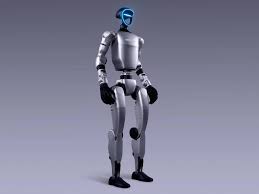Robotics – Use of Robots in Industries and Daily Life
Robots are very interesting. I like robots a lot because they can do many things like humans, but they don’t get tired. When I was small, I saw robots only in cartoons and movies. I thought they are fake. But now I know robots are real, and they are used in many places in the world.
A robot is a machine which works on its own. Some robots are big, some are small. Some look like humans, but many look like simple machines with arms or wheels. Robots don’t have feelings like us, but they can work fast and correctly.

Robots in Industries
The first place where robots were used is in industries. Factories need work that is quick and without mistakes. Humans can work hard, but we get tired and we make mistakes. Robots can do the same work without stopping.
-
Car factories: Robots make cars. They join the parts, weld the metal, and also paint. They can do it much faster than humans.
-
Dangerous work: Robots do work that is not safe for humans. For example, working with fire, chemicals or heavy machines.
-
Electronics: Phones and laptops are made of very tiny parts. Robots can fix these small parts easily.
-
Food industry: Robots pack biscuits, chocolates, chips and other food. This is clean and fast.
So in industries, robots are like perfect workers. They don’t get tired, and they don’t complain.
Also Raed:Top 10 Upcoming Tech Trends in 2025 – Latest Innovations
Robots in Daily Life
Robots are not only in factories. Now they are slowly coming into our daily life too.
-
At home: There are vacuum robots that clean the floor. Some robots also cut the grass in the garden. I wish I had one robot at home that could clean my room and do my homework.
-
In hospitals: Robots help doctors in surgeries. They can do very small and accurate work. Some robots also take medicine and food to patients.
-
In schools: Robots are used as helpers. They can teach languages, maths, and even coding. Studying with a robot would be fun.
-
In restaurants and airports: Robots serve food in some restaurants. In airports, robots give information and guide passengers. Delivery robots are also being tested to bring food and parcels to homes.
-
For fun: Some robots are made only for entertainment. There are robot dogs and cats which can play with kids. I think having a robot pet would be very cool.
Advantages of Robots
-
Robots are fast and save time.
-
They don’t get tired or bored.
-
Robots do dangerous jobs safely.
-
They make fewer mistakes than humans.
-
Robots at home save time and energy.
Disadvantages of Robots
-
Robots are very expensive.
-
They can take away jobs from people.
-
Robots don’t have feelings or creativity.
-
If they break, the work stops.
-
Using robots too much can make humans lazy
Future of Robots
The future of robots is very exciting. Scientists are making robots smarter with artificial intelligence. Maybe in the future, robots will be teachers, farmers, or police officers. They might even build houses on Mars or clean the oceans.
But we should be careful. Robots should not replace humans. They should only help us. Humans are creative and emotional, and robots cannot be like that. If humans and robots work together, life will be better.

Conclusion
Robots are one of the best inventions of modern technology. They are used in factories, homes, hospitals, schools and restaurants. They make our life easy, fast and safe. But they also have some problems like high cost and job loss in my opinion, robots should be our helpers, not our replacements. If we use them wisely, they can make our future bright.
Also Raed:AI in Gaming – How Artificial Intelligence is Changing 2025
FAQs
Essay: Robotics use of robots in industries and daily life
Robotics is the branch of technology that designs, builds, and uses robots to perform tasks. In industries, robots are used in manufacturing, assembling, welding, painting, and packaging. They increase efficiency, accuracy, and safety by handling dangerous or repetitive jobs. In daily life, robots appear in homes, hospitals, schools, and even entertainment. From vacuum cleaners to surgical robots, they save time and assist humans. Robotics continues to grow, making life easier, safer, and more productive.
Examples of robotics in everyday life
-
Robotic vacuum cleaners (Roomba)
-
Self-driving cars
-
Smart assistants (Alexa with robotic functions)
-
Robotic lawn mowers
-
Medical robots (surgery, patient care)
10 Uses of Robots
-
Manufacturing
-
Packaging
-
Welding
-
Space exploration
-
Surgery
-
Bomb disposal
-
Agriculture
-
Education
-
Household cleaning
-
Military defense
10 Examples of Robots
-
Roomba (vacuum robot)
-
ASIMO (Honda humanoid)
-
Sophia (humanoid robot)
-
Spot (Boston Dynamics dog robot)
-
Da Vinci Surgical Robot
-
Atlas (Boston Dynamics)
-
Pepper (social robot)
-
Robotic arm in factories
-
Mars Rover (Perseverance, Curiosity)
-
Drone robots
5 Uses of Robots
-
Healthcare (surgery, assistance)
-
Home cleaning
-
Military missions
-
Space exploration
-
Industrial production
Robots in Everyday Life
Robots help with cleaning, cooking, medical care, deliveries, entertainment, education, and security.
7 Types of Robots
-
Industrial robots
-
Service robots
-
Humanoid robots
-
Medical robots
-
Military robots
-
Space robots
-
Autonomous vehicles
Uses of Robots in Home
-
Cleaning (vacuum/mop robots)
-
Lawn mowing
-
Security (camera robots)
-
Cooking assistants
-
Elderly care robots




